Schemes for arranging ventilation systems in an apartment building
In order to make it comfortable in the premises, and the air exchange to be in accordance with the standards, each residential building is equipped with a ventilation system. This also applies to multi-story buildings, which represent the main segment of urban housing.
During the construction, standard schemes of ventilation systems in an apartment building are used, thanks to which various modes of air circulation are implemented.
In this article, we will analyze the features of traditional schemes, the subtleties of arranging ventilation with coercion, and the nuances of arranging the ventilation of a sewer system.
The content of the article:
Schematic diagrams of natural ventilation
Long-term practice of building apartment buildings has led to the fact that several of the most effective schemes for creating a ventilation system have been selected. The choice of a particular scheme depends on many factors: the shape of the building, the number of floors, street air pollution in the area, noise level.
Schemes of a traditional exhaust system
The system of exhaust ventilation with a natural motivation is recognized as traditional, that is, when the air exchange in the rooms is due to the difference in temperature and pressure.
It means that the exhaust air is discharged through ventilation shafts and channels to the outside (to the roof), and fresh air enters through windows, doors or special supply valves.
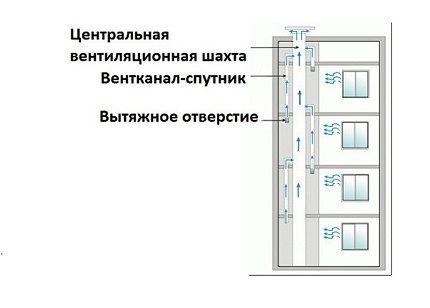
The option of laying separate mines for each apartment is not currently considered, since it was advisable in the era of low-rise construction.
It is clear that for skyscrapers from 9 floors and above, it is physically not possible to equip many parallel-going channels.
Therefore, in construction, two recognized rational schemes are used:
- All mines are displayed in the attic and there are united by a horizontal channel.Polluted air is removed from the channel through a single outlet, arranged in the most convenient place.
- Separate apartments join the common riser (mine) in parallel located satellite channels, so the exhaust air is discharged above the roof along vertical channels.
The fundamental difference lies in two points: the presence / absence of a horizontal collector in the attic and the presence / absence of common mines in risers.
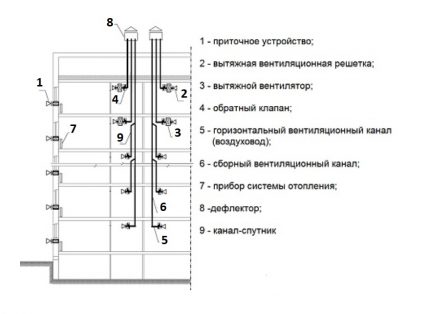
Local withdrawal from the upper floors is due to the fact that to create traction above the apartment there must be a horizontal channel of at least 2 m in height.
Separately withdrawn channels, like a common shaft, must be thermally insulated, otherwise condensation will form in the attic, as a result of which premature destruction of materials occurs, mold appears.
Installation of a horizontal attic box is made taking into account special requirements. For example, its diameter should be sufficient so that reverse thrust is not created and air does not return to the channels. This is fraught with the ingress of waste environment into the apartments of the upper floors.
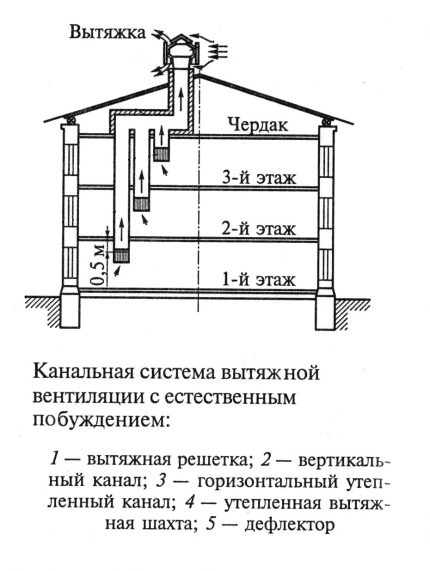
Sometimes it is not possible to mount a bulky horizontal channel. Then they get by with a narrow section of the pipe, but for the upper floors they use the same local system - separate hoses introduced into the attic.
Natural ventilation, which is equipped with almost all houses of the old buildings, has a significant plus - it does not need power supply.
However, its effectiveness depends on the temperature difference in the building and the room, and the mines and canals require continuous cleaning, which in practice is extremely rare.
Features of the location of the channels in a 9-storey building
In typical houses, the process of changing air is performed in natural mode. The influx of fresh air masses occurs in apartments, the exhaust medium is discharged through ventilation shafts equipped with satellite channels.
Most often, the channels are laid from the exhaust openings in the apartments according to the “through 2 floors” scheme, but can also be floor-mounted.
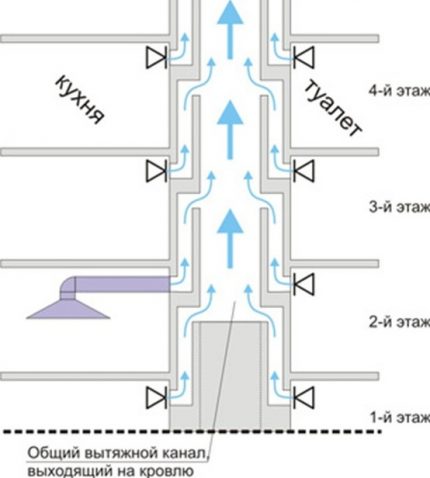
According to the norms, the withdrawal from 8-9 floors is carried out not through a common shaft, but separately. When drawing up such a scheme, average atmospheric conditions are taken into account, that is, the air temperature in the street is +5 ° C and the absence of wind.
This scheme is recognized as ineffective, because with changing environmental conditions, the functionality of natural ventilation decreases. For example, in extreme heat it is useless. Clogging of the ventilation ducts is also possible, which completely blocks the movement of air.
In the absence of a normal hood, emergency cleaning is required. Although usually it is carried out every 5-6 years.
Forced type systems
In modern housing construction, plastic and metal-plastic constructions are used to seal window and balcony openings. Double-glazed windows made of polymers and aluminum are stronger than wood, but often completely block the natural channels of fresh air.
Doors also tightly adjoin to a floor, making rooms absolutely tight. Air intake does not occur, and in the absence of an effective supply system, the exhaust system becomes useless.
To solve the problem of access to fresh air in all apartments, special equipment is installed in elite residential buildings - forced-air and exhaust installations.
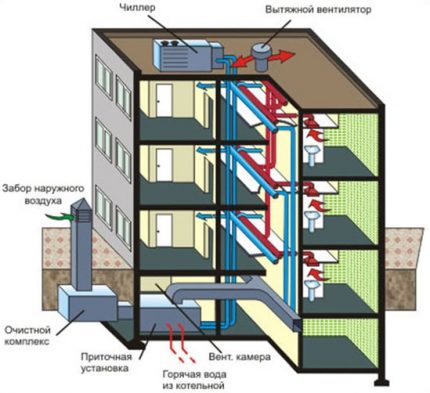
The supply and exhaust ventilation system is quite complex, and for the installation of its individual elements it will be necessary to allocate a place in the basement (supply air heating) and on the roof (fan and chiller).
Unlike natural ventilation, the motive is volatile. In addition, it consists of a set of complex devices that are controlled from a single remote control.
SHUV is installed next to the supply equipment, in the basement, and only qualified service personnel have access to it.
We can say that in residential high-rise buildings there are all three types of ventilation, and natural is the most common, and the installation of a forced or combined system is still limited.
Organization of air circulation in the apartment
Consider how air circulates in a single apartment without installing additional air exchange devices.
As mentioned above, fresh air enters through all kinds of window cracks and gaps, as well as through doorways - ajar doors and cracks under them.
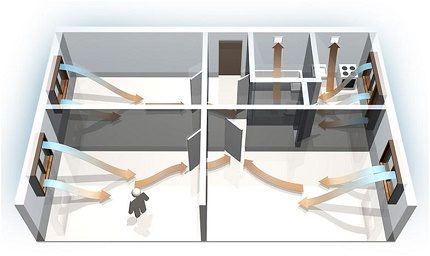
Comfortable living in apartments is characterized by a number of factors, among which the frequency of air exchange and the volume of regularly changing air.
There are rules governing the flow of air.

In old buildings, ventilation shafts do not always function 100%, and this can be checked in a simple way. You need to take a piece of paper and attach it to the technical ventilation hole. If a piece of paper does not hold on by traction and falls, natural ventilation is impaired.
Instead of a sheet, you can use a burning candle or match. By the movement of the flame tongue, it becomes clear whether there is a pull from the room to the outside.
In more detail, we examined the rules for checking ventilation in the apartment and the ways to find the problem in another article.
Problems with ventilation negatively affect the well-being of people living in apartments. The lack of fresh air causes unhealthy drowsiness, fatigue, headaches.
Particularly sensitive to this are people with diseases of the heart and respiratory system. They constantly want to keep the windows and windows open, and this leads to a sharp cooling of the rooms and, as a result, an increase in the number of colds.
We also recommend that you read how to restore ventilation and duct performance.
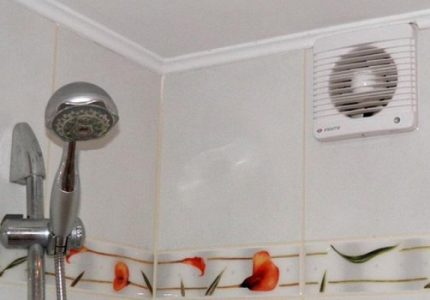
If a cooker hood with a regularly exhausted hood is installed over the stove, it will also help to quickly change the air masses in the kitchen and in adjacent rooms.
If desired, tenants can independently organize the flow of air. To do this, use both ordinary ventilation and special mechanical and technical devices, for example, supply valve on the window.
Valves are installed not only on double-glazed windows, but also in walls, most often under windows, near heating appliances. Air from the street enters the room through a small hole with a diameter of 5 to 10 cm and is heated due to the heat of the radiator or convector.
There are automatic models that are sensitive to changes in temperature and humidity: as soon as the parameters exceed the norm, airing occurs.
But the centralized supply system of the channel type is recognized as more perfect. You can install it yourself only in a private house, because in high-rise buildings, systems of this magnitude are engaged in special services.
Air ducts and air supply / heating devices are located above rooms, in ceilings, pass through walls, therefore they are installed during the construction process.
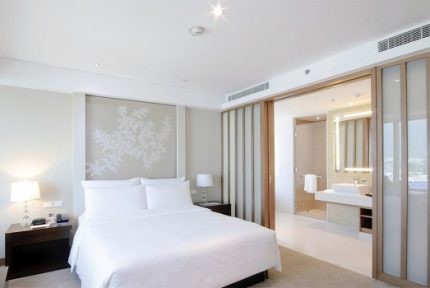
As you can see, the absence of a well-established natural ventilation system can be partially compensated by the installation of additional devices. There is only one minus - additional one-time expenses for the purchase of devices and regular expenses for the payment of electricity.
How is sewage ventilation?
The removal of unpleasant sewer odors is also necessary for a comfortable stay in apartment buildings. The system of "ventilation" of the sewage system is simplified to a minimum: gases are discharged through the same riser as drains are discharged.
To prevent unpleasant odors from disturbing residents, the riser is equipped with a continuation facing the roof - a ventilation (fan) pipe.
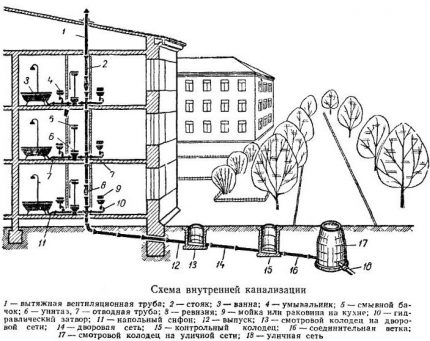
Knowing the scheme, you can understand why the work on the redevelopment of bathrooms requires permission. If you change the location of the riser or connect a large number of plumbing fixtures, the operation of the ventilation system may be impaired.
When equipping a sewer network, taking into account ventilation, the systems are guided by SNiP 2.04.01-85.
Conclusions and useful video on the topic
To improve ventilation on their own, it is necessary to consult with professionals and choose the most economical and effective way.
Expert opinions of specialists:
On the uniform operation of two or more ventilation ducts:
What are turbo deflectors for:
How to install a supply valve:
The natural ventilation regime characteristic of apartment buildings does not always fully pay off. If a forced centralized network is not provided for in the building, then air inflow / outflow can be arranged independently, using household devices.
Do you live in a high-rise apartment? Share your experience in arranging a ventilation system, tell us what devices you use to ensure complete and timely air exchange in all rooms of the apartment. Leave your comments under our article - your advice can be useful to many apartment owners.

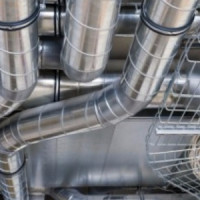 Arrangement of ventilation to the ceiling: types of ventilation systems and features of their arrangement
Arrangement of ventilation to the ceiling: types of ventilation systems and features of their arrangement 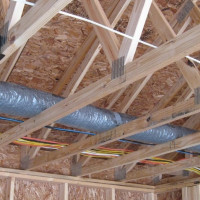 Ventilation in the house from sip panels: the best options and layouts
Ventilation in the house from sip panels: the best options and layouts 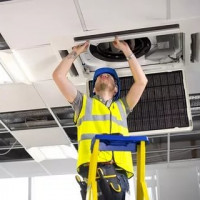 Design and installation of ventilation systems: the best schemes + installation nuances
Design and installation of ventilation systems: the best schemes + installation nuances  Typical schemes and rules for designing a ventilation system in a private house
Typical schemes and rules for designing a ventilation system in a private house 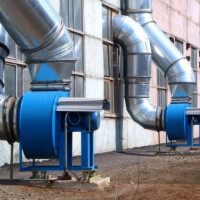 Types of ventilation systems: a comparative overview of the options for organizing ventilation systems
Types of ventilation systems: a comparative overview of the options for organizing ventilation systems 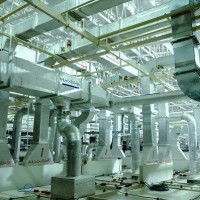 Requirements for ventilation of public buildings: subtleties of arrangement and design of ventilation
Requirements for ventilation of public buildings: subtleties of arrangement and design of ventilation  How much does it cost to connect gas to a private house: the price of organizing gas supply
How much does it cost to connect gas to a private house: the price of organizing gas supply  The best washing machines with dryer: model rating and customer tips
The best washing machines with dryer: model rating and customer tips  What is the color temperature of light and the nuances of choosing the temperature of the lamps to suit your needs
What is the color temperature of light and the nuances of choosing the temperature of the lamps to suit your needs  Replacement of a geyser in an apartment: replacement paperwork + basic norms and requirements
Replacement of a geyser in an apartment: replacement paperwork + basic norms and requirements
In my opinion, with regard to forced ventilation, the information is too generalized. And, in principle, it is not clear for whom it is intended: a private trader does not need it, and specialists know that forced ventilation is a complex system. In addition to the fan and the inlet, there are many other devices, for example, a muffler relies on the fan. If it’s completely according to the rules, then every multi-story building should have a smoke exhaust system. Sorry for the categorical.
Woman, why is there to get into these nuances? Specialists already know how to do it right, and the average person can make an expert out of himself who knows that a silencer is needed for the fan. Why expand your horizons?)))
Hello. In many MCD ventilation systems are not installed by the rules. People literally choke on the premises and are moldy. The nuances of knowing are sometimes very useful to protect your rights.
Dear “Expert”, the Soviet construction system implied that, whatever they did, it would still work correctly and works wherever there is no construction marriage. This is about 1% of the Hood activity of the residents of the house who create the unimaginable, up to the dismantling of the common ventilation shafts. And the rights we have to download only idiots and smart can do no harm to themselves.
As for your highlight - “Woman”: “Olive Dennis designed a ventilation system for trains, in which clean fresh air is supplied to each passenger individually.”
Existing natural draft systems in multi-storey buildings are extremely inefficient. Exhaust hoods with fans over the stove are popular for exhausting smoke, odors and oil vapors. These umbrellas are connected to exhaust ventilation manifolds, so they can create excessive pressure in the collectors and polluted air will go to neighboring rooms.
So Salda blindly believes in “experts” in vain. The most correct solution is to install industrial exhaust fans to extract air from the manifolds.
Hoods that Vladimir worried you about are the initiative of the residents, not the result of the creation of vicious projects. There is a document - “PTE of the housing stock”, which begins with clauses prohibiting redevelopment, changes in sanitary-engineering, other systems (ventilation also enters there). See paragraphs 1.7.3, 1.7.4.
Regarding forced extraction, there are also a few lines that allow installation only fans in the bathrooms, kitchens of the upper apartments of high-rise buildings (screenshot attached). It turns out that the installation of an umbrella equipped with a fan is unacceptable. The next inspection of the apartment by the representative of the Criminal Code will end with the dismantling of the umbrella.